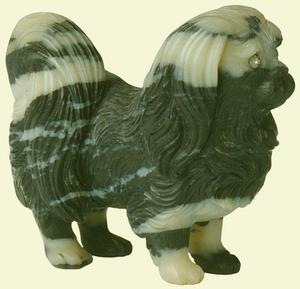
It was a really bad idea to steal a Pekingese in 19th century China. Pamphlets and publications of the time warned that apprehended dog-nappers would face stoning – or worse (what could be worse???) – being cut into a thousand pieces.
Such extreme punishment didn’t dissuade British soldiers from absconding with at least five Pekes during the Second Opium War, though admittedly, an empty Imperial Palace that October day in 1860 made the taking seem easy, particularly since the dogs were found near the body of a woman, dead by her own hand. Far from being a rescue operation, however, accounts of the time suggest an all out sacking of the palace, and what couldn’t be carried away was smashed. One source writes that the Chinese government later estimated that about 1.5 million items were taken. The Eighth Earl of Elgin who was present during the plunder wrote: “There was not a room I saw in which half the things had not been taken away or broken in pieces.”
Among the “loot” were five dogs known as the time as “Chinese Pugs, Pekins, or Chinese Spaniels, and one of them, the dog that would be presented to Queen Victorian as a political gift and named, “Looty,” was the first Pekingese in Britain.
Victoria had a large number of dogs, many of which lived in the Royal Kennels, but she also had dogs with whom she had (if one  could put it this way), “personal relationships.” Sadly, it doesn’t seem that Looty was one of them. The little Peke was too small and lacked the temperament to fare well in a residence filled with boisterous dogs, and it sounds as if he lived out his life for the next eleven years in loneliness. Harper’s Weekly via the New York Times wrote:
could put it this way), “personal relationships.” Sadly, it doesn’t seem that Looty was one of them. The little Peke was too small and lacked the temperament to fare well in a residence filled with boisterous dogs, and it sounds as if he lived out his life for the next eleven years in loneliness. Harper’s Weekly via the New York Times wrote:
He was a very lonely little creature, the other dogs taking exception to his Oriental habits and appearance, and when the Prince and Princess of Wales returned from a Continental trip, the latter pleaded with her mother-in-law to be allowed to take Looty to Sandringham. About six months later Looty’s mate arrived from China, and the breeding of this species of dog became a diversion in fashionable society.
When he died in 1872, Looty got no ornate monument or fancy gravestone as had other favored dogs. In fact, no one even knows where the little dog was buried.
Image: Pekingese figure by Carl Fabergé (UK, 1907) made of precious stone, from The Royal Collection © 2012, Her Majesty Queen Elizabeth II.
